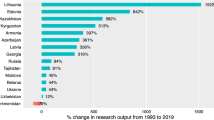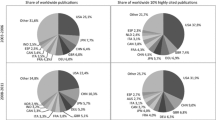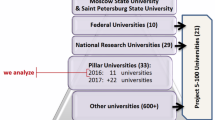Abstract
In this paper a three-dimensional framework to see how Indian universities and research-focused institutions fare in the world of high end research in terms of excellence and diversity of its research base is proposed. At the country level scholarly performance is broken down into three components—size, excellence and balance or evenness. A web application available in the public domain which visualizes scientific excellence worldwide in several subject areas is used. India has a presence in fifteen of twenty-two subject areas in which there are at least 50 institutes globally that have published more than 500 papers. It has no institution which can be counted at this level of size and excellence in seven areas: Arts and Humanities; Business, Management and Accounting; Health Professions; Neuroscience; Nursing; Psychology; and Social Sciences. India’s research base is completely skewed towards the Physical Sciences and Engineering with very little for Biological Sciences and Medicine and virtually none in Social Sciences and Arts and Humanities when excellence at the highest level is considered. Its performance is also benchmarked against three nations, namely Australia, The Netherlands and Taiwan which are of similar size in terms of GDP and scientific output. It is seen that although India has the highest GDP among the four countries, its performance lags considerably behind. Even in terms of diversity, its performance is poor compared to the three comparator countries.



Similar content being viewed by others
References
Anon. (2015). The value of structural diversity: Assessing diversity for a sustainable research base. Digital Science and the Science Policy Research Unit, University of Sussex, Dec 2015.
Bornmann, L., Stefaner, M., de Moya Anegón, F., & Mutz, R. (2014a). Ranking and mapping of universities and research-focused institutions worldwide based on highly-cited papers: A visualization of results from multi-level models. Online Information Review, 38(1), 43–58.
Bornmann, L., Stefaner, M., de Moya Anegón, F., & Mutz, R. (2014b). What is the effect of country-specific characteristics on the research performance of scientific institutions? Using multi-level statistical models to rank and map universities and research-focused institutions worldwide. Journal of Informetrics, 8(3), 581–593.
Bornmann, L., Stefaner, M., de Moya Anegón, F., & Mutz, R. (2015). Ranking and mappping of universities and research-focused institutions worldwide: The third release of excellencemapping.net. COLLNET Journal of Scientometrics and Information Management, 9(1), 61–68.
Garfield, E. (1955). Citation indexes to science: A new dimension in documentation through association of ideas. Science, 122(3159), 108–111.
Garfield, E. (1999). Journal impact factor: A brief review. Canadian Medical Association Journal, 161(8), 979–980.
Garfield, E. (2005). The agony and the ecstasy: The history and meaning of the journal impact factor. International Congress on Peer Review and Biomedical Publication. http://garfield.library.upenn.edu/papers/jifchicago2005.pdf.
Hirsch, J. E. (2005). An index to quantify an individual’s scientific research output. Proceedings of the National Academy of Sciences of the United States of America, 102(46), 16569–16572.
Katz, J. S. (2005). Scale-independent bibliometric indicators. Measurement, 3(1), 24–28.
Kogleck, L., Priyadarshini, S., Pincock, S., & Bocquet, A. (2015). Indian science ascending. http://www.natureindex.com/news/indian-science-ascending. Dec 2015.
Leydesdorff, L., & Bornmann, L. (2011). Integrated impact indicators compared with impact factors: An alternative design with policy implications. Journal of the American Society for Information Science and Technology, 62, 2133–2146.
Pendlebury, D. A., & Adams, J. (2012). Comments on a critique of the Thomson Reuters journal impact factor. Scientometrics, 92(2), 395–401.
Prathap, G. (2011a). The energy–exergy–entropy (or EEE) sequences in bibliometric assessment. Scientometrics, 87, 515–524.
Prathap, G. (2011b). Quasity, when quantity has a quality all of its own—toward a theory of performance. Scientometrics, 88, 555–562.
Prathap, G. (2014a). Quantity, Quality, and Consistency as Bibliometric Indicators. Journal of the American Society for Information Science and Technology, 65(1), 214.
Prathap, G. (2014b). The zynergy-index and the formula for the h-Index. Journal of the American Society for Information Science and Technology, 65(2), 426–427.
Stirling, A. (2007). A general framework for analysing diversity in science, technology and society. Journal of the Royal Society, Interface, 4, 707–719.
Zhang, L., Rousseau, R., & Glänzel, W. (2016). Diversity of references as an indicator of the interdisciplinarity of journals: Taking Similarity between subject fields into account. Journal of the Association for Information Science and Technology, 67(5), 1257–1265.
Acknowledgements
The author is extremely grateful to the creators of the web applications, Lutz Bornmann, Division for Science and Innovation Studies, Administrative Headquarters of the Max Planck Society, Hofgartenstr. 880,539 Munich, Germany; Rüdiger Mutz, Professorship for Social Psychology and Research on Higher Education, ETH Zurich/MUG, Mühlegasse 21, 8001 Zurich, Switzerland; Moritz Stefaner, Truth & Beauty Operator; and Felix de Moya Anegón, CSIC/CCHS/IPP, SCImago Group (Spain), Communication and Information Science Faculty, University of Granada, Granada, Spain for making the applications available in the public domain. He has also benefitted from discussions with Lutz Bornmann. He is also grateful to the reviewers for their very helpful comments that have considerably improved the presentation.
Author information
Authors and Affiliations
Corresponding author
Rights and permissions
About this article
Cite this article
Prathap, G. A three-dimensional bibliometric evaluation of recent research in India. Scientometrics 110, 1085–1097 (2017). https://doi.org/10.1007/s11192-016-2181-1
Received:
Published:
Issue Date:
DOI: https://doi.org/10.1007/s11192-016-2181-1




